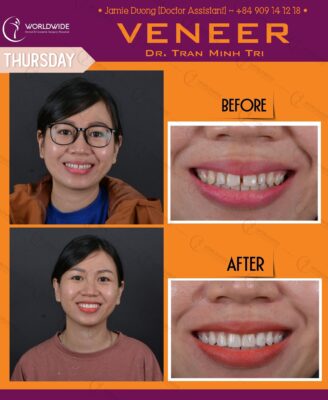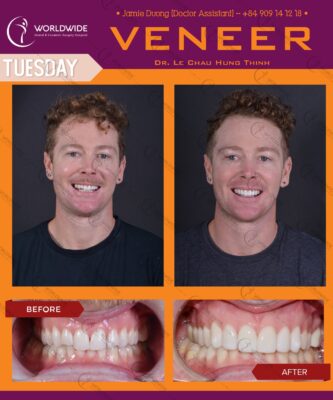What is Composite Veneer/Bonding?
 Bonding a tooth gives an alternative to veneers when your goal is to restore a tooth or teeth that have been chipped, cracked, misaligned or discoloured.
Bonding a tooth gives an alternative to veneers when your goal is to restore a tooth or teeth that have been chipped, cracked, misaligned or discoloured.
Dental veneers (sometimes called porcelain veneers or dental porcelain laminates) are wafer-thin, custom-made shells of tooth-colored materials designed to cover the front surface of teeth to improve your appearance. These shells are bonded to the front of the teeth changing their color, shape, size, or length.
Types of Dental Veneers?
Dental veneers can be made from porcelain or from resin composite materials. Porcelain veneers resist stains better than resin veneers. They also better mimic the light-reflecting properties of natural teeth. You will need to discuss the best choice of veneer material for you with your dentist.
Who is a good candidate for Veneer?
Veneers are routinely used to fix:
-
Teeth that are discolored because of:
-
Teeth that are worn down
-
Teeth that are chipped or broken
-
Teeth that are misaligned, uneven, or irregularly shaped (for example, have craters or bulges in them)
-
Teeth with gaps between them (to close the space between these teeth)
The Procedure of Composite Veneer/Bonding
Getting a dental veneer usually requires three trips to the dentist – one for a consultation and two to make and apply the veneers. One tooth or many teeth can undergo the veneering process at the same time.
◊Diagnosis and treatment planning
You will tell your dentist the result that you are trying to achieve. During this appointment, your dentist will examine your teeth to make sure dental veneers are right for you and discuss the procedure and some of its limits. They may take X-rays and possibly make impressions of your mouth and teeth.
◊Preparation
To prepare a tooth for a veneer, your dentist will reshape the tooth surface, which is an amount nearly equal to the thickness of the veneer to be added to the tooth surface. You and your dentist will decide whether they numb the area before trimming off the enamel. Next, your dentist will make a model, or impression, of your tooth. This model is sent out to a dental laboratory, which makes your veneer. It usually takes 2-4 weeks for the veneers to come back from the laboratory. Temporary dental veneers can be used in the meantime.
◊Bonding
Your dentist will place the veneer on your tooth to examine its fit and color, repeatedly removing and trimming the veneer to achieve the proper fit, before permanently cementing it to your tooth. The veneer color can be adjusted with the shade of cement to be used. Next, to prepare your tooth to receive the veneer, your tooth will be cleaned, polished, and etched. Etching roughens the tooth to allow for a strong bonding process. A special cement is applied to the veneer and it is then placed on your tooth. Once the veneer is properly positioned, your dentist will shine a special light beam on it to activate chemicals in the cement, causing it to harden very quickly. The final steps involve removing any excess cement, checking your bite and making any needed adjustments. Your dentist may ask you to return for a follow-up visit in a couple of weeks to check your gums and the veneer’s placement.

 Bonding a tooth gives an alternative to veneers when your goal is to restore a tooth or teeth that have been chipped, cracked, misaligned or discoloured.
Bonding a tooth gives an alternative to veneers when your goal is to restore a tooth or teeth that have been chipped, cracked, misaligned or discoloured.
